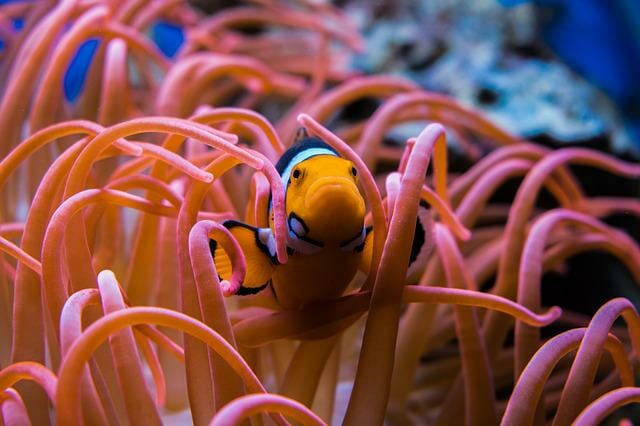Biggest Clownfish: Sizes of Most Famous Clownfish Species

Clownfish are a species of fish commonly kept in tanks by aquarium owners. These fish are famous for their bright colors and energetic personalities. Clownfish are also known for producing bubbles and creating colorful patterns with their fins. These colorful fish are typically small, around four inches long, but some clownfish can get up to four and a half inches long.
The giant clownfish is believed to be the Gold Stripe Maroon Clownfish (Premnas biaculeatus). This fish can reach a maximum size of six inches in length.
Table of Contents
Size Differences in Popular Clownfish Types
Clownfish come in different sizes, with the minor type reaching just three inches long and the largest reaching six inches. The variations in length can be attributed to how well they swim, as larger clownfish are better able to move around more easily and thus tend to have longer bodies. Additionally, clownfish with longer body lengths can better accommodate themselves in their stream habitats.
Common Clownfish (Amphiprioninae)
The Common Clownfish is the most common type of clownfish and can be found in the Pacific Ocean. They are usually bright orange and can grow up to 4.3 inches long (11 cm). It is one of the easiest clownfish to keep, requiring little care other than regular water changes and occasional feedings of healthy food. This is the most popular clownfish among aquarium enthusiasts due to its stunning coloration and hardy nature. However, like all different types of clownfish, they have their pros and cons that one should consider before acquiring them as pets.
True Percula Clownfish (Amphiprion percula)
The True Percula Clownfish is prevalent and can be found in the Pacific Ocean. They can grow up to 4.3 inches long (11 cm). They are also some of the most colorful clownfish, with bright colors that can vary depending on their location. They eat small fish and other invertebrates, and they are very active fish that love to swim around. In addition, they require very little care, and they are considered the most accessible type of clownfish to keep.
Cinnamon Clownfish (Amphiprion melanopus)
The Cinnamon Clownfish is a clownfish found in the Indo-Pacific Ocean. They are usually dark red to orange colors. They grow up to 4.7 inches long (12 cm) and are very active fish that love to swim around. They eat small fish and other invertebrates, and they are one of the most accessible types of clownfish to keep providing you provide them with plenty of hiding spaces.
Moreover, they require very little care, and they are one of the most popular types of clownfish among people.
Tomato Clownfish (Amphiprion frenatus)
The Tomato Clownfish is another type of clownfish found in the Pacific Ocean. They are usually yellow, orange, or blackish, and they grow up to 5.5 inches long. They are one of the most accessible types of clownfish to keep, requiring little care other than regular water changes and occasional feedings of healthy food. They feed on small fish, crustaceans, and algae.
Maroon Clownfish (Premnas biaculeatus)
The Maroon Clownfish is the largest clownfish species and can reach up to 6 inches in length. They are usually dark red or dark brown. They are one of the most active types of clownfish and love to swim around constantly. They feed on small fish and other invertebrates, and they are straightforward to keep providing you provide them with plenty of hiding spaces. You can also feed them algae and leftover food from other fish.
Clarkii Clownfish (Amphiprion clarkii)
The Clarkii Clownfish is a clownfish found in coral reefs around the world. They are usually yellow to brown and can reach up to 4 inches long. They are one of the most accessible types of clownfish to keep, requiring little care other than regular water changes and occasional feedings of healthy food. Clarkii Clownfish can also be found in various marine parks and aquariums.
Pink Skunk Clownfish (Amphiprion perideraion)
The Pink Skunk Clownfish is a clownfish found in the Indian Ocean. They are usually pink or peach colored and can reach up to 4 inches long. They are one of the most active types of clownfish and love to swim around constantly. They feed on small fish, crustaceans, and algae. In addition, they are not as hardy in captivity, so they require relatively large aquariums.
Saddleback Clownfish (Amphiprion polymnus)
The Saddleback Clownfish is one of the most popular types of clownfish and can be found in many different parts of the world. They are usually brown or black and can reach up to 5 inches long. They are one of the most accessible types of clownfish to keep, requiring little care other than regular water changes and occasional feedings of healthy food. Saddleback Clownfish can also be found in various marine parks and aquariums.
General Care for Clownfish

To care for clownfish, you will need to provide them with plenty of hiding spaces and a stable environment. You should also feed them healthy food containing various types of small fish and other invertebrates. Additionally, you should water your clownfish regularly and change their water every two or three days. So, the first thing you will do when you get your clownfish is to create a suitable living environment.
If space isn’t an issue, then using one larger tank in which you can set up several smaller tanks within the more significant maximum of two gallons should work nicely. However, getting your clownfish into this working tank means limiting how much water it may be exposed to daily.